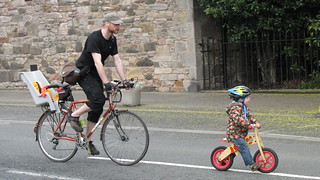... usual warning about responding to the comments.. ;0)
CityCyclingEdinburgh Forum » General Edinburgh
1 in 5 commuters in Edinburgh cyclists!
(33 posts)-
Posted 12 years ago #
-
Without reading beyond headline, if they mean on any given day, 20% of commuters are cyclists, then all I can say to that is "cobblers".
Posted 12 years ago # -
I agree. I'm sure a proper survey could be carried out, but trying to extrapolate the short survey is statistically useless.
Posted 12 years ago # -
More click-bait on their website. They get ad-revenue from each click. Thumbs up, thumbs down comments etc. The stories swing from ones designed to outrage cyclists to those to outrage motons. All with the same goal. Avoid.
Posted 12 years ago # -
That's a cracking result if it's valid.
Posted 12 years ago # -
...which it presumably isn't, given the comments above!
Posted 12 years ago # -
Today struck me as being particularly busy for bicycles traversing the Meadows when I cycled through at 8:50am.
"The proportion was even higher on Forrest Road where cyclists made up 22 per cent of the traffic heading into the heart of Edinburgh over the same period. The number of bikes was less than half as high for southbound routes."
So the number of bikes was half as high for southbound routes, but what about the number of motor vehicles? I imagine that fewer people were driving out of town at that time of day as well, so the proportion may still have been similar. Having said that, I would be rather worried if there were any cyclists or motor vehicles commmuting South-bound on Forrest Road given that it is one-way!
Posted 12 years ago # -
to outrage motons
Is 'motons' a new word? If so, I like it - describes a certain breed of EEN commenter perfectly!
Posted 12 years ago # -
Doesn't the original spokes release say 1in 5 on 'some routes'?
When you think how many cyclists peel off before hitting forest rd, that's pretty impressive. (It's also one of my least favourite roads to cycle, although it may be slightly better at rush hour, given tougher restrictions on loading then).
Posted 12 years ago # -
Oh, beautiful.
How to have an epic fail with statistics.20% of all the vehicles on one road is not the same as 20% of all the people using that road. Fortunately most buses have more than one passenger, and even some cars have more than one occupant! (though IIRC from the Spokes article, not many...)
Posted 12 years ago # -
@panyagua motons has been around for a while, I've seen it before. Some people feel it is a bit too insulting, I think, after all most of us who cycle can and do also drive.
Posted 12 years ago # -
London papers etc did just the same. 'vehicles' on bridge translated into 'commuters' even though this obviously didn't include buses or the underground.
never let the facts get in the way of a good story.
Posted 12 years ago # -
@fimm - thanks for clearing that up. I agree, many of us do drive and own cars, but I would assert that (of itself) doesn't make us motons. If I use it, I'll reserve it for the particularly opinionated, narrow-minded and ill-informed section of the motoring public that comments in the EEN and suchlike.
Posted 12 years ago # -
@panauya @fimm I often read it as 'moutons' ie sheep in French. Which also seems appropriate on several levels.
Posted 12 years ago # -
This survey doesn't do we cyclists, or Spokes, any favours.
The extrapolation is completely flawed.
On my route, the vehicles outnumber the cyclists by more than 100:to:1, plus the buses are carrying 20-50 people each.I'm amazed... no wait, scratch that, no I'm not.. that the EEN didn't question the figures and simply reported them as fact.
Posted 12 years ago # -
...and then there are the trains...
So, I dunno - maybe 1 in 250 commuters are cyclists?
Posted 12 years ago # -
The Spokes article says quite clearly "more than one in every five vehicles heading for the city centre along bike-unfriendly Lothian Road was a bike…"
What the EEN news do with that is hardly Spokes' fault!
Posted 12 years ago # -
The EEN with selective reporting and/or an agenda? Who'd have guessed?
Posted 12 years ago # -
Graphically. -
Posted 12 years ago # -
The flaws in Spokes' traffic counts have long been obvious but continuing to do it is a perfectly good campaigning trick. It's nonsense but let's not be naive - this isn't about counting cyclists in any scientific sense. This is about finding an increasing number of cyclists and using it as a basis to argue for improved provision. Psyops. Or, in this case, Cyops.
Posted 12 years ago # -
@chdot
Graphically.I'd delete that chart at the bottom. The flat one that shows close to zero over the entire period.
Posted 12 years ago # -
Hypothetically speaking, if you were anti-cycling, wouldn't you just love to come across some little statistical trick like this one to try to blow apart the whole pro-cycling cause? 'Look, they're manipulating the figures, we can't trust them...'
Also hypothetically, if someone was doing a similar thing with counting cars to try to justify building more roads, what exactly would the reaction here be?
Posted 12 years ago # -
Surely they'd need to be counting numbers of people driving /without/ roads... that's the whole point?
A better analogy would be a count of people walking where there is no pavement, perhaps.
Posted 12 years ago # -
People do that sort of thing to justify building roads all the time. Have you never seen them standing at the sides of busy junctions with clipboards and clickers counting the various vehicles?
It's not a statistical trick, it's a campaigning device. You go to places that attract cyclists and count cyclists. But you can't tell how much of the growth you record is new cyclists and how much of it is displacement from other less attractive routes. But in campaigning terms it doesn't matter - there's more of them and that's what counts.
Sustrans does the same things with its routes.
Posted 12 years ago # -
how much of it is displacement from other less attractive routes.
Are there many less attractive routes than Lothian Roads.
Posted 12 years ago # -
Dunno. But Spokes acknowledge how their counts might be affected by displacement. They just can't account for it.
"For years interpretation of our data has been plagued by the shutting and reopening of roads for tram works, resulting in sometimes massive shifts of motor traffic, with knock-on effects on numbers of cyclists and the road conditions for cycling. This is the first count where all roads are re-opened, so hopefully comparisons will be easier in future years."
That's the physical displacement. There's also the possibility of displacement in time as people adjust their travel times to either avoid congestion or take advantage of it. It's conceivable, you certainly see it on the Forth Road Bridge, that people travel both earlier and later to avoid queuing (resulting more in longer periods when the bridge is congested). You could easily have fewer cars in rush hour with no overall reduction in the number of cars - just a spreading of them.
Anyway, I'm not criticising Spokes or suggesting that they do their counting differently. It's fine. I like it. But I don't necessarily believe it.
Posted 12 years ago # -
"But I don't necessarily believe it"
Which bit(s).
I think that recording numbers of bikes and cars is valid/useful as it shows trends. But the concentration on vehicles rather than people is slightly odd and misses important stats/trends.
I am not clear if they count occupant levels in all cars or just conclude that most are single occupant by anecdote or sample.
It's good that bike numbers are up. It's good if car numbers are down. It's probably better if more of the cars have passengers - but if that shows that a smaller proportion of 'commuters' travel by bike...?
This is also (significantly) an issue with bus use (and in a different way pedestrians).
It's good that bike use is increasing it's (probably) good that Scottish Government now (KB at recent CS conference) wants to increase cycle commuting numbers.
BUT the issue is (in the Spokes survey context) surely the number of people travelling at two points.
Is the total number increasing? Is the modal shift altering?
In London a lot of the pro-cycling work is because it's cheaper than building more tube/rail routes (though they are doing that) or providing extra buses.
Edinburgh hasn't really got such equivalent 'problems'. There are bus routes where buses pass stops already full - not just travelling to the city centre.
The tram might actually have noticeable benefits for people working at Gyle/EP.
Spokes has done a good job of demonstrating that there has been an increase in cycling - and very adequately argued (successfully) for more spending.
At present CEC is concentrating more on the Family Network than the 'commuting network' - largely busy roads with lots of (potential) conflicts.
There needs to be a better 'discussion' on travel/transport/modal shifts etc.
This will need to involve serious discussion about discouraging/restricting car use (or deciding not to...)
This will need stats/facts - and shouldn't 'rely' on Spokes.
Posted 12 years ago # -
What do I not believe?
There's a sampling technique called 'river sampling', I guess because it draws an analogy with how you would test the water from a river. You stick your probe into the flow and take your sample. The underlying assumption is that the flow is constant and that it wouldn't matter a great deal where and when you sampled. You would probably still take samples over a number of time periods and in a number of places to validate your initial assumption.
If you wanted to count traffic you would realise that river sampling wouldn't work if all you did was sample in a few places for a fixed period - the flow is not constant and the likelihood is that any time period you chose would probably be different from other periods you could choose. Because of that you would be unable to generalise.
If your river was actually a pipe of fixed volume, you'd realise that trying to measure the volume of water moving through over a fixed period, especially at a time of peak flow was likely to run up against the capacity of the pipe. Your measure would have a capacity constraint and to measure the volume of water moving through the pipe you'd need to extend your measurement time to cover the period just before it reaches capacity to just after it reaches capacity.
The problem of capacity constraints would be exacerbated if your pipe had many inlet and outlet pipes and other pipes that could divert water away from and around the pipe you're trying to measure. In that case you'd want to measure flow at all of the points where water could be diverted.
But I agree, it's not Spokes' job to collect the data so I mean this as no criticism of them. That they do anything at all is to their credit and to the shame of the people who should be doing it.
Posted 12 years ago # -
Many of the points in this conversation are answered on the Spokes counts web page which is linked to from our news story.
Obviously what the press make of it is a different story. Also note that the headline in a press article is often not even written by the journalist who does the story, and so can be wildly misleading, as in the recent Evening News article.
Posted 12 years ago # -
Two problems I see with the river/water analogy are that river flow varies due to the weather, not the time of day - with a road surely you would want to consistently measure at the same time; and (in Edinburgh at least) I doubt bike flow can ever reach capacity.
Posted 12 years ago #
Reply »
You must log in to post.

 posts
posts
